UNWTO Names Mestia among Best Tourism Villages


United Nations World Tourism Organization names Mestia among the Best Tourism Villages of 2022.

“Mestia, with its fascinating nature and rich history has remarkable monuments of Georgian architecture and ethnography including churches, monasteries, traditional towers, and local buildings. The village has a diverse landscape, rich in forest areas and alpine zones and is famous for attracting world-renowned sports championships.
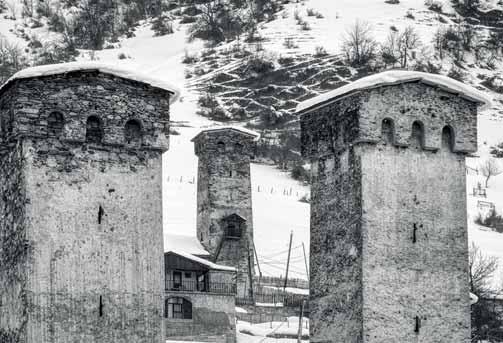
A hiking and trekking paradise over the snowy mountains in Mestia offers skiing and snowboarding for eight months of the year,” the WTO said.
The Best Tourism Villages aims to recognize a village which is an outstanding example of a rural tourism destination with recognized cultural and natural assets, that preserves and promotes community-based values, products and lifestyle and has a clear commitment to sustainability in all its aspects – economic, social and environmental, with the fundamental aim of making tourism one of the drivers of positive transformation, rural development and community well-being.
Issue no: 1379 • • DECEMBER 23 - 29, 2022 • • PUBLISHED WEEKLY In this week’s issue... PRICE: GEL 2.50 BUSINESS PAGE 6 NEWS PAGE 2 Crisis Economy: Trends, Features And Possible Development. Part 1 Ukrainian Children from Olympic School of WarAffected City of Mykolaiv Visit Tbilisi Terabank Issued $6.5 Million in Perpetual AT1 Bonds China, and the Russia-West Rivalry Zelensky to US Congress: Against All Odds, Ukraine Didn’t Fall Hoda Ceramics - Journey of an Architect Becoming a Ceramist BUSINESS PAGE 8 FOCUS PAGE 9 Ensuring a Harmonized Human–Nature Relationship on Kakheti Steppes: Balancing between a Living Landscape or a Future Desert ON THE KAKHETI STEPPES SOCIETY PAGE 10 CULTURE PAGE 11 POLITICS PAGE 4 Markets of BONDSPricew/wm/mSTOCKSPricew/wm/m GRAIL 07/2888.11 (YTM 6.62%) +0,1%+10,2% Bank of Georgia (BGEO LN)GBP 24.75 5,0% 2,4% GEBGG 07/23100.68 (YTM 4.83%) +0,2%+0,1% Georgia Capital (CGEO LN)GBP 7.44 1,3% 0,1% GEOCAP 03/2495.59 (YTM 10.05%) +0,8%+1,4% TBC Bank Group (TBCG LN)GBP 21.50 2,1% 1,4% SILNET 01/2794.62 (YTM 10.00%) +0,2%+1,8% TBC 06/2498.35 (YTM 6.93%) 0,0% +0,2% CURRENCIESPricew/wm/m GEL / USD2,6593 0,5% 2,0% GEL / EUR2,8204 +0,1%+0,6% COMMODITIESPricew/wm/m GEL / GBP3,2298 1,6% +0,1% Crude Oil, Brent (US$/bbl)79,80 +2,3% 8,9% GEL / CHF2,8660 +0,3%+0,8% Gold Spot (US$/OZ)1 787,62 +0,3%+2,1% GEL / RUB0,0389 8,5% 13,2% GEL / TRY0,1425 0,6% 2,3% INDICESPricew/wm/m GEL / AZN1,5676 0,5% 2,1% FTSE 1007 361,31 1,1% 0,3% GEL / AMD0,0068 0,3% 1,9% FTSE 25018 648,96 0,9% 3,3% GEL / UAH0,0720 0,6% 2,0% DAX13 942,87 2,5% 3,4% EUR / USD0,9428 0,7% 2,7% DOW JONES32 757,54 3,7% 2,9% GBP / USD0,8231 +1,0% 2,1% NASDAQ10 546,03 5,4% 5,4% CHF USD0,9286 0,8% 2,7% MSCI EM EE30,67 +1,5%+3,0% RUB / USD68,3125 +8,7%+12,6% MSCI EM957,64 0,6% +1,6% TRY
SP
AZN
MSCI
AMD USD394,1300
/ USD18,6516 +0,0%+0,2%
5003 817,66 4,3% 3,7%
/ USD1,6970 +0,0%+0,0%
FM2 098,99 1,8% +2,1%
0,2% 0,3% PreparedforGeorgiaTodayBusinessby
Mestia, Svaneti. Photo by Tony Hanmer.
Zelensky to US Congress: Against All Odds, Ukraine Didn’t Fall
comes after he made a surprise trip to the front-line city of Bakhmut in eastern Ukraine on Tuesday. There, he met soldiers defending the city from Russian forces, who have been trying to capture it for months.
Zelensky praised the bravery and fortitude of troops and civilians in the Donetsk city, saying, “Bakhmut Fortress. Our people. Unconquered by the enemy. Who, with their bravery, prove that we will endure and will not give up what’s ours. Ukraine is proud of you. I am proud of you! Thank you for the courage, resilience and strength shown in repelling the enemy attacks.”
The small city of Bakhmut in eastern Ukraine has seen some of the fiercest hand-to-hand fighting of the war in recent months due to its strategic and symbolic importance.
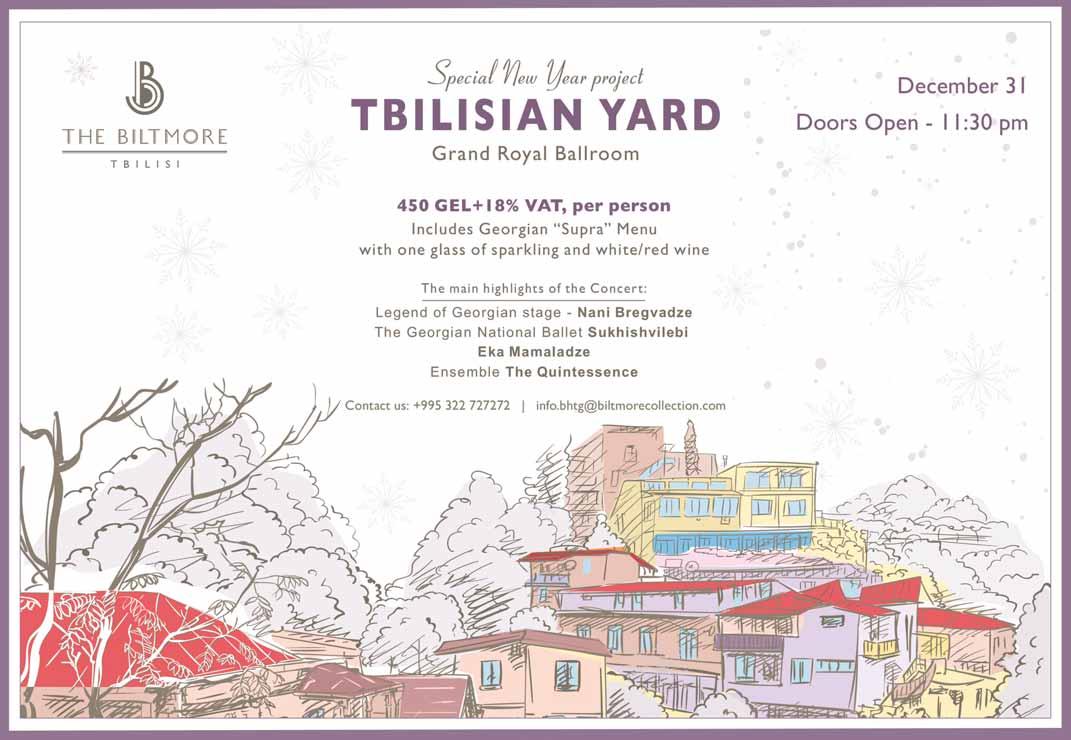 BY ANA DUMBADZE
BY ANA DUMBADZE
Ukraine’s President Volodymyr Zelensky arrived in the US on Wednesday morning. US President Joe Biden and Zelensky met at the White House for a bilateral meeting between high-ranking officials from both nations, followed by a joint press conference where Biden pledged to help the young leader for “as long as it takes.” The Ukrainian leader gave a historic 32-minute address to US lawmakers at the Capitol building in Washington, D.C. on Wednesday night.
“Against all odds and doom and gloom scenarios, Ukraine didn’t fall. Ukraine is
alive and kicking,” Zelensky said to a loud round of applause and standing ovation.
“The battle is not only for life, freedom and the security of Ukrainians or any other nation which Russia attempts to conquer,” he said, “the struggle will define in what world our children and grandchildren will live.”
Zelensky assured Americans that their money wasn’t being wasted in Ukraine, saying its soldiers knew perfectly well how to operate complex US weapons systems and planes.
Earlier in the day, Secretary of State Antony Blinken announced a $1.85 billion military package for Ukraine that includes a Patriot missile system, which Russia has warned the US against sending to Ukraine.
The Ukrainian President’s US visit
ZELENSKY EVOKES BATTLE OF THE BULGE, SARATOGA IN APPEAL TO US CONGRESS
Zelensky received loud applause from the US Congress Wednesday night as he compared Ukraine’s fight for its survival to US battles from World War II and the American Revolution.
He compared Ukraine’s ongoing defensive stand against Russian troops in the east of the country around Bakhmut to American troops’ successful defense against German troops in the Battle of the Bulge in 1944. Both battles raged through the Christmas season.
Zelensky went on to say he hopes for a turning point in the Ukraine war in 2023, similar to the American revolutionaries’ victory at Saratoga. At that series of battles in 1777, Americans defeated imperial British troops in Upstate New York.
France began openly supplying the Americans with arms after Saratoga, and continued weapons shipments were part of Zelensky’s plea before Congress.
“We Ukrainians will also undergo our war of independence with dignity and success,” the Ukrainian President said.
MORE UKRAINIAN BATTLEFIELD VICTORIES ARE THE ONLY PATH TO PEACE, SAYS BIDEN

At a press conference with Zelensky, Biden told reporters the only path to peace was through more Ukrainian victories on the battlefield.
The war “could end today if Putin had any dignity at all, and did the right thing and just said, ‘pull out.’ But that’s not going to happen,” said Biden.
“So what comes next? We’re going to
continue to help Ukraine succeed on the battlefield,” Biden said. “It can succeed on the battlefield with our help and the help of our European allies and others. So that, if and when President Zelensky is ready to talk to the Russians, he will be able to succeed, because he will have won on the battlefield.”
Biden’s remarks reflect the belief within the White House that Ukraine will never agree to peace talks as long as Russia still occupies Ukrainian land, and that Putin will never voluntarily retreat from the country.
US officials acknowledge that an even longer war will require even more American support for Ukraine, something Zelensky was expected to speak on when he addressed Congress on Wednesday night.
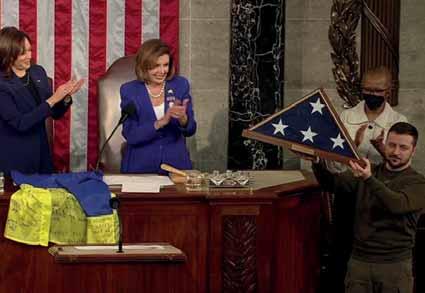
GEORGIA TODAY DECEMBER 23 - 29, 2022 2 NEWS

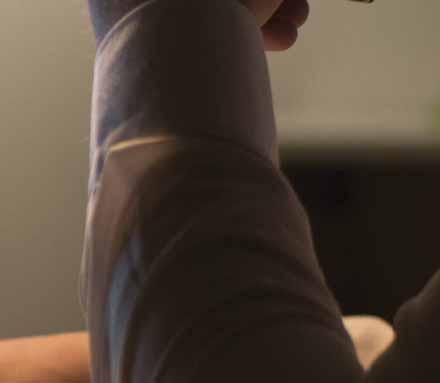




























































































































Lenovo recommends Windows 11 Pro for business PREMIUM BUSINESS ULTRABOOK
China, and the Russia-West Rivalry
 ANALYSIS BY EMIL AVDALIANI
ANALYSIS BY EMIL AVDALIANI
The Russia–West struggle is seen as defining in modern geopolitics, but China’s approach to this rivalry is little discussed. For China’s imaginary map of the Eurasian landmass, the lands lying to the west, from Xinjiang to Portugal and Scandinavia, is the space where China’s rise to pre-eminence will be played out. Deeply jutted into the Eurasian continent, China’s geography makes the country highly vulnerable to potential instability in Central Asia, Afghanistan, and Russia. And though it is often argued that China’s economic rise is the most important aspect of the quickly changing world order, it should be also said that economic progress, albeit grand in scale, could not alone reshape the world. As any aspiring great power in world history before, China would also need opportune geopolitical circumstances on the Eurasian landmass to advance its Eurasia-wide interests. One such opportunity is being provided by the Russia–West confrontation. For the Chinese, both Russia and the West fall within one category: Those which once pursued establishing a colonial presence on China’s territory and presently regarding the country’s successes as threatening. There is no outright
hatred, but the vision that Russia, the US, and other western powers are not particularly happy with China’s geopolitical rise is well ingrained within the communist state’s political culture. It is thus in China’s interests to keep its Eurasian powers as divided as possible. The tradition of playing one against another is reflected nowadays in Beijing’s policy of tacitly: At times openly supporting Moscow in the latter’s confrontation with the West, whether through votes in the United Nations or deeper economic and military cooperation in the time of western sanctions imposed on Russia.
This allows China to have Russia as a distraction, since the US constantly has to dedicate time, military, and economic resources to contain Russia in Africa, the Middle East, or the Black and Mediterranean seas. This Chinese approach creates a certain chaos among the group of states which were historically prone to dominating China. In this game, Russia is a mere pawn in China’s Eurasian geopolitical calculus, whose growth of influence under Putin is not as fundamental as that of China. Thence come reservations in Beijing about potential Russia/China-led Eurasia. The different geopolitical weights of the two states preclude an even distribution of influence. China will be close to Russia as long as it helps Beijing keep the West distracted from the Indo-Pacific.
The Russia–West confrontation is also beneficial to China in the light of Russia’s policies in the Middle East. The region is economically important to Beijing, but it has traditionally been dominated by the Western powers. Over the last decade or so, Western influence in the region diminished, while Russia’s actions further disrupt America’s posture. In the long run, China could play a more active role in the resource-rich region, because of the region’s geography as one of the connection points with European market within the framework of the BRI.
A look at the map of China shows what the country’s geopolitical imperatives have been throughout most of its history. Perhaps the first goal of all successive Chinese dynasties and then the com-
munist government has been to maintain control over the heartland, Han core, which consists of major Chinese rivers, is abundant with productive lands, and is full of people. A further logical step is the influence over zones which surround the Han core and consist of mountainous regions to the west, desert lands to the north-west, and impregnable forests in the south.
The third major imperative is to protect China’s coastline from foreign powers. In the medieval period, intermittent military naval incursions into the Indian Ocean or attempts to dominate Japan and other neighboring islands were made. It could be argued, though, that the Chinese did not see any long-term need to develop powerful naval capabilities, because external threats emanating from
sea were non-existent. Geographic barriers as well as external threats, almost exclusively emanating from the nomads in the north, limited political and trade contacts with the outside world and conditioned China’s nearly autarkic economy. China’s insularity was a significant geopolitical advantage. It provided security in ancient period and middle ages. But this was no longer a case in the twentieth century when in the age of globalization, international trade, and multiplicity of supply chains, China has to be open and rely upon raw materials from abroad via sea routes. Thence comes China’s fourth geopolitical imperative—security of international trade lines and diversification of resource bases. This will only be possible to achieve through establishing alternative land routes, such the as BRI, or building a powerful military fleet capable of protecting supply chains across the Indo-Pacific. Modern China does both, which makes it a far stronger challenge for America than what was the Soviet Union. This stresses the need to look beyond parallels with the Cold War era. The latter is a limiting framework which does not cover the whole scope of present competition between Washington and China.
Emil Avdaliani is a professor at European University and the Director of Middle East Studies at the Georgian think-tank, Geocase.
An Examination of War Propaganda from the Kremlin Perspective
BY MICHAEL GODWIN
The term “drinking the Koolaid” is an allegory to the Jonestown Massacre, but generally refers to any group or individual that is so devout in a belief that they will die for their cause. This belief is typically something that is false, or which attempts to obfuscate the truth. For many observers and analysts, this has become synonymous with people who firmly believe the Kremlin’s narrative of its “special military operation” in Ukraine.
The “denazification” of the country and, to a lesser extent, the fight against the “perverse values of the West,” lies at the core of Russian President Vlaidimir Putin’s causus belli. Ukraine has been painted as vile, aggressive, and fascist by Russian state-owned media and the legion of social media accounts that parrot the Kremlin lines.
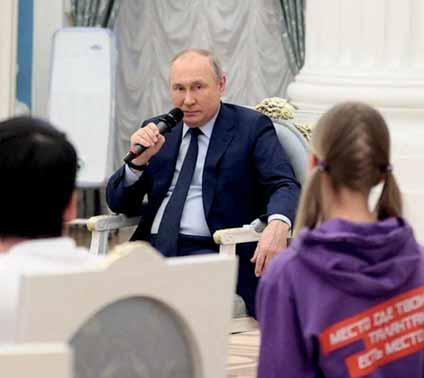
The war has been framed as an inevitable but just cause that is righteous and good as a cleansing of what is “Russian land” anyways. To better understand this, it must be viewed through the Kremlin’s eyes.
to step in and halt the movement of Georgia Westward, check the ambitions of Tbilisi, and preserve the place of the Osstian people in the Russian world.
Ukraine is, has been, and ought always to be a part of the Russo-Slavic brotherhood. It is the jewel of the empire and the breadbasket of the Slavic world. The goal and glorious cause is to cut NATO’s puppeteer strings on Kyiv and liberate the Ukrainian people. This is evident in the harsh criminal penalties in Russia for referring to the war as anything other than a special military operation, and the capture of towns and cities as anything other than a liberation.
Even Georgia saw this. The 2008 intervention came as a result of American and broadly Western imperialism into Russia’s sphere. With the West’s imperialistic ventures into Iraq and Afghanistan, the Kremlin would not stand by and allow this intrusion into the South Caucasus, still a part of the great empire. No, the justified intervention of a peacekeeping force was required. They had
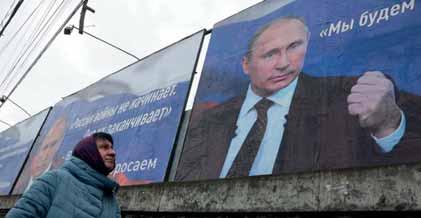
After all, where would Georgia be without the Russian empire and later the Moscow-led Soviet Union? The country would still be an agrarian backwater, with little to no industrialization, and no significant investment or development. Following the work of the Motherland, and the fall of communism, they ran to the West, the opponent for so many decades.
Next, the West targeted Ukraine. The coup against the legitimate government in Kyiv, likely orchestrated by the CIA, in 2014, was another transgression by America and its European partners. It was only when the armed groups of the Donbas region stood up against this that changes could be made. However, for their outspoken stance, the people of these regions were shelled in their homes, at school, and at their workplaces.
As such, it is the job of Russia, once again, to fight the fascist invader. This has always been the mission of the Russian people. After all, there would have been no timely end to WWII without the Red Army. And even prior to this Great Patriotic War, Russia had been
under the boot of almost every major empire in history. Napoleon’s France, Ottoman Turkey, Imperial Japan, The Kaiser’s Germany, internal fighting against the Tsarists, and finally Hitler’s Germany all ravaged the Russian world.
And it is this final struggle against the predations of Nazi Germany that defined the path forward for Russia. Russia, and the Soviet Union as a whole, contributed more towards the ultimate victory in Berlin than any other country in the Alli-
ance combined. The Soviet citizenry suffered more than any other country under Nazi occupation and, as such, the raising of the Victory Banner over the Reichstag on April 30, 1945, is one of the single proudest moments for the country.
So, today, it is the same fight, but with different faces. Kyiv facilitates the armament of groups like Right Sector, Svoboda, and infamously the Azov Regiment, who promulgate fascist and Neo-Nazi ideologies. This facilitation is encouraged by its Western allies and NATO. In order to avoid another great suffering of the Russian people, a ‘denazification’ is not only warranted but required for national preservation and Russian sovereignty.
And thus it is: The Russian perspective that justifies a war in Ukraine. The intricate ties to Russia’s history, along with its slight Kremlin-produced adjustments, are deep rooted and tethered to its national identity. This identity is also mirrored in its reporting of the war.
Anyone, from the casual observer to the full-time analyst who peruses proRussian news and social media, is aware of the popular line “everything is proceeding according to plan.” This has been the cornerstone of almost all formal and informal reports that come from the Kremlin, its media outlets, and pro-Putin military bloggers alike. The facade being posted for all to see that the special military operation is a success, with Ukrainian “gangs” and “militants,” as they’re often referred to as, being forced back at every opportunity.
This is particularly telling in the media being released to the public. High quality, sixteen-by-nine, video of artillery
firing salvos, infantry shooting into buildings (albeit seemingly empty), and fighter jets releasing munitions off towards unseen targets are the most common. These show units at the highest readiness capability, wearing the latest in combat webbing and kit, and all displayed taking offensive action.
Perpendicular to the official videos, open-source clips shot by the soldiers themselves paint another picture. Antiquated kit, rusted or outdated weaponry, and a glaringly urgent morale and supply problem permeate the majority of Russian military formations. This, topped with the multiple retreats by the military, termed as ‘strategic regroupings’, has undermined much of the Kremlin's narrative.
Interestingly, as a result of these regroupings, many of the pro-Russian accounts online have begun to pivot their narrative as a result of this. From what was a tonal undercurrent of advancing towards key cities and seizing ground, this tone has shifted to one of defensive positioning. The action is no longer described as victories, but rather as a defense against the onslaught of the “Ukro-fascits” and the West. It is no longer an invasion, but rather an attack by Kyiv on Russia. These online hubs, particularly in places such as VKontakt, OK.ru, and Telegram are the largest culprits for this veneer of propaganda. With little to no oversight, pro-Russian channels are able to share information that is so far from reality, it bends the mind of any Western reader. The production of ‘dirty bombs’ by Kyiv’s scientists, the assertion that Ukraine has no air defense, and the Russian Air Force moves unobstructed in the skies over western Ukraine, and the ‘fact’ that NATO is about to begin fighting internally are only some of these absurd claims.
This circles back to the Russian perspective and their history of invasions. It is essential to the narrative, and a core component of driving support for a war that now cannot be won. As so many of the people are poised since youth to believe the word of the Kremlin and its press network, it is easy to see how much of the country can continue their support. However, Russia cannot continue this charade forever. At some point in the near future, the harsh reality will have to be revealed, and a popular fallout will most assuredly ensue. Perhaps, in a backwards way, everything does indeed “proceed according to plan.”
GEORGIA TODAY DECEMBER 23 - 29, 2022 4 POLITICS
THE READER SHOULD NOTE THAT THE FOLLOWING IS WRITTEN FROM THE PERSPECTIVE OF RUSSIA AND IS BASED ON REPORTS, ARTICLES, AND POSTS FROM PRO-WAR RUSSIAN SOURCES.
Russian President Vladimir Putin during a meeting with a panel of young Russians. Source: Sputnik/AFP Via Getty Images
Posters bearing images of Russian President Vladimir Putin and reading "Russia does not start wars, it ends them" (left) and "We will aim for the demilitarization and denazification of Ukraine.” Source: Stringer/AFP via Getty Images
Image source: atlanticcouncil.org

Thoughts on the War
OP-ED BY NUGZAR B. RUHADZE
The war is still raging in Ukraine, but nobody is sure about the name it will go down in history with: Russian-Ukrainian, RussianWestern or Russian-American. The only sure thing about it right now is that it is happening in beautiful Ukrainian land, torn and devastated as it is, and is being fought with the hands of Russians and Ukrainians, longtime ethnic and religious twins. The entire world is thinking about this conflict this or that way, but nobody has an instantaneous solution that might start saving lives in this cursed turmoil, including the lives of Georgia’s own sons, who have opted to battle shoulder-toshoulder with their Ukrainian fellow combatants, inspired by various understandable objectives. The frequent wordy statements that we hear from Western, Russian and Ukrainian politicians and analysts are so contradictory, that their ambiguity creates insurmountable doubts in our heads, depriving us of a chance to make any logical conclusions or do some independent reasonable analysis. It is said that the Biden administration is finalizing plans to send the Patriot missile defense system to Ukraine, and Germans are getting ready to ship their Leopard tanks in the same direction.
BUSINESS
This means that the West has finally made a decision to strengthen Ukraine with the long mediated for and longawaited military power. The delay has been justified only due to the fear of escalating the conflict into a wider-scale war, moving it beyond the boundaries of its current theater. The predominantly
prevalent sentiment all over the world is that Ukraine should win it. Yet, while the Ukrainians confidently nurse the idea of taking back all its occupied lands, there is no clear view of the finale out there. Some experts are sure that a full Ukrainian victory is almost impossible to imagine at this time. It is also said that
a lot depends on the way Ukrainians behave along the frontline, as well as in their relationships with the West, because without Western support, Ukraine can fall victim to the conflict at a moment’s notice. The dependence of Ukraine on Western aid is overwhelming, and the Western readiness to provide that aid is crucial. That’s why any delayed shipment of armaments is equal to catastrophe for the Ukrainian armed forces, but it seems the West has finally realized that they are faced with an existential threat not only to Ukraine but to the entire free world too.
The shadow of the Second World War, seen in the current actions in modern Ukraine, becomes more and more imposing, telling the Westerners that the possibility of wars anywhere in the world, including in their territories, affecting the idyllic serenity of their lives, has not vanished at all. And this is scary! Hence the grand wakeup in the West, expressed in their preparedness to go for real in terms of maximized supply of Ukraine with some game-changing weapons.
Another question is if Russia ever succumbs to the destructive power of those arms, soon expected to arrive where the adversities are on the rise between the warring sides. One expert made an almost oxymoronic comment that Russia has to suffer a defeat in order for her to become a better place to live.
One of the most prominent political
writers of our time, Henry Kissinger, is urging a negotiated peace in Ukraine to reduce the risk of another devastating world war, but the Ukrainian leadership qualifies the outstanding expert’s proposal as a direct attempt to appease the aggressor, commenting that there could be no deal that envisages the possibility of ceding any of the previously seized territories. Says Kissinger: “A peace process should link Ukraine to NATO, however expressed. The alternative of neutrality is no longer meaningful.”

There is also a lot of hearsay about World Cup organizer FIFA’s rejection of a request from the Ukraine President to deliver a message of world peace ahead of the tournament's final in Qatar. Could this be symptomatic, on top of a myriad of other thoughts that pop up for reflection in this war time? What happens if Russia and Ukraine never agree to talk, the West continues sending modern armaments to keep the war going, Russia continues taking out vital Ukrainian infrastructure, and the world remains impotent to promote the peace process? Most importantly and perilously, what if the Western united military effort pushes the beleaguered Russia into a corner? Not even the world-level united think-tank will answer this question any time soon, and not because they are not qualified enough, but only because the entire world is at a loss, having only questions without answers.
Crisis Economy: Trends, Features And Possible Development. Part 1
BY VICTOR KIPIANI, CHAIRMAN OF GEOCASE
After the global economic crisis of 2008, a number of critical problems remain unresolved. The list of these macro- and microscale problems is quite extensive. However, despite this abundance, it is still possible to formulate several general theses characteristic of all of them: (1) due to the (voluntary) reduction of the role of the state, as an impartial arbiter, the healthy principles of market economy gradually atrophy; (2) under the influence of uncontrolled egoism, oriented to super-profit, social synergy is broken; (3) due to the resulting inequality and, in some places, lack of perspective, vices appear that threaten not only the order within the state, but also the stability and order necessary for the global system of international relations.
In this year's final article, we sought to point out, through our own observations and assessments, several trends and events which are not only statically significant for the economic structure, but which will also have a significant impact on its formation in the foreseeable future. It is clear that my assessments made here to the judgment of the reader, as a noneconomist, are done from an "amateur point of view," which is supported by a personal interest in the subject and a multifaceted legal practice. Accordingly, this article, too, speaks to the reader by avoiding categorical conclusions, using balanced assumptions, and making judgments to activate further reasoning.

However, it seems to us that the fact that modernity has faced not one or two, but many systemic crises, the socalled "poly-crisis," should not cause heated debate. And this makes it extremely difficult to correctly perceive, analyze and, most importantly, resolve the difficulties.
The peculiar synchronization of crises of different nature or content in the current regime (the global pandemic, significant damage to the pre-pandemic supply network, the recession of major economic centers, the war in Ukraine, the decline of China's export potential, etc.) draws attention: That is, if not all, then several crises explode in one par-
ticular geography, in one particular time, simultaneously and with equal force. And, given the high degree of "interconnectedness and interdependence" of the world economy, the "export" of crises from one geography to another became widespread, eventually leading to a multiplicity of systemic crises: The world "poly-crisis".
Importantly, the current situation provides a sufficiently clear basis for investigating cause-and-effect relationships, as well as for identifying possible future trends. Our intention is to highlight and articulate some of these in a concise format. Understanding the current process will be useful not only to have insight into global events, but also to determine where and how these events can lead our country; to anticipate, plan and prepare better so that we do not become passive observers of global transformation; to take care and act so that, by drawing sound and timely conclusions, we can increase our own social and public resilience, the competitiveness of the Georgian state, and our ability to adapt.
So, let's give specific names to the main trends and systemic events that have only been mentioned.
THE (UNINTENDED) CONSEQUENCES OF POLY-CRISIS?
It is a generally accepted axiom that any crisis is welcome as long as it allows us to draw the right conclusions and make decisions. In spite of the dramatic nature of the situation today, even so, there are trends that create opportunities for justifiable intervention in processes. At the same time, there are also trends that, whether or not the different people approve or disapprove of them, are the objective consequential manifestation of existing challenges.
Let us now turn directly to some of them, provide their brief description and assess their relevance.
RECONSIDERING THE LIBERAL ECONOMIC ORDER
It is one of the fundamental pressing issues involved in reassessing free market relations. This is not a question of a complete rejection of the existing market system. Of course not. In fact, academic circles (as well as practitioners) are now openly discussing the dangers of uncontrolled reliance on market
Image source: reuters.com
instincts, when such lack of control, or "culture of self-regulation" by corporate actors, is detrimental not only to ordinary citizens, but also to the stability of state and society, the stability of the world economy and its systemic development.
THE RETURN OF THE STATE TO THE ECONOMY
Once again, it must be said that the creation and distribution of the wealth requires an impartial arbiter. And only an actor oriented toward secure and inclusive development, providing equal access to the means of realization and supporting social solidarity can be such an arbiter: The state. In doing so, its unconditional role is to create a reasonable balance between the demands of the healthy forces of the market economy and adequate public expectations. Without such a moderate and reasonable balance, it is impossible to achieve longterm peace in the country, nor to fully and competitively activate national economic resources in the foreign economic arena. Obviously, the next few years will
give us more reason to better judge the modern manifestation of Neo-Keynesianism in the state economy.
SOCIAL WELFARE SYSTEM
One of the main conditions for preserving national-state strength and stability is that not only should no member of society feel excluded, but that they should be perceived as a full participant in society. And the way to such participation is through economic policy and legislative measures that enable a citizen, a member of society (obviously, subject to their will and appropriate skills) to find their place in the process of nationwide development. The convergence of grand political objectives and specific human needs is unique in that it involves the realization of such a wide range of goals that lead to increased national security, the strengthening of the structure of social resilience, and the creation of an appropriate environment for personal fulfillment.
A NEW SOCIAL CONTRACT
The relevance of talking about the need
for a new social contract has increased, and we must consider its role again and again along with the above-mentioned topics. Its essence is expressed in the greater involvement of business in the nation-building agenda, its greater social support for society, and its greater responsibility for nationwide development. In short, it is about what business and the business community (including in Georgia) have always more or less done and managed. However, given our times and realities, this needs to be done "in excess": more systematically, deeply, thoughtfully, consistently. There is no doubt that a new economic culture formed on the basis of a new social contract between the state, business and society ("contract" here is a conditional word and refers to a new norm of interdependence, unwritten norms of behavior) will help fill the public gaps, reduce national threats and manage risks to the development of the state. Thus, all three "signatories" to the new social contract will benefit equally and proportionately.
GEORGIA TODAY DECEMBER 23 - 29, 2022 6 POLITICS
To be continued in next week’s GT.
Henry Kissinger: “A peace process should link Ukraine to NATO, however expressed. The alternative of neutrality is no longer meaningful.” Source: AP

Terabank Issued $6.5 Million in Perpetual AT1 Bonds
Terabank issued $6.5 million of perpetual AT1 bonds to the market. This allows Terabank to increase its credit portfolio and offer customers, especially small and mediumsized businesses, which are a strategic segment of the bank, even more diverse loan products and services tailored to their needs.

The perpetual AT1 bonds were purchased by the Chairman of Terabank's Supervisory Board, His Highness Sheikh Nahayan Mabarak Al Nahayan. With this step, he once again confirmed his stable support for the bank and its long-term development goals.
Perpetual AT1 bonds are classified as additional primary capital. By issuing it, Terabank's capitalization level was further strengthened, creating an optimum capital structure and increasing the bank's sustainability.
"The issuance of perpetual AT1 bonds is a transaction of special importance for Terabank. With their help, we will further expand the loan portfolio and the product line which will provde additional opportunities for our customers — both business customers and individuals," Terabank said.
His Highness Sheikh Nahayan Mabarak Al Nahayan owns 65% of Terabank's shares. He has been a member of the Federal Government of the United Arab Emirates since 1992 and currently holds the post of Minister of State for Tolerance. At the same time, Sheikh Nahayan Mabarak Al Nahayan heads the Dhabi Group which is the leading business group of the United Arab Emirates and operates in various directions.
Georgian Brand Day 2022
On December 28, the public relations agency Profile will hold a grand awarding ceremony for successful companies. "Georgian Brand Day" is one of the most innovative and recognized projects, a fact confirmed by participating companies, supporters, sponsors, public opinion leaders and media feedback. Georgian Brand Day will this year be hosting successful national brands for the 20th time.
The foundation of the project was laid in 2003, when Georgia was in the worst economic situation. The first event was salon-style, and only wine producing companies participated. But since then, throughout the long existence of the project, many companies of different
profiles, which have gained international recognition, have appeared on the Georgian market and are now successfully operating.

"Profile Study" will identify winners in six main nominations:
• Leader;
• Reputation and trust;
• Successful new brand;
• Successful TV project;
• A successful international project;
• Brand-person.
The goal of the project is to promote the formation and promotion of Georgian brands in the domestic and foreign markets; establish healthy competition methods and technologies in companies; form an ethical business environment; stimulate the social responsibility of
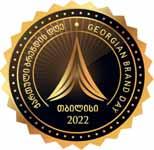
companies; and support positive processes in Georgian business and provide information to the public.
“When we started working on the project, the word ‘brand’ was so foreign to the public that we had to explain its meaning... two decades have passed since then, and many brands were created in Georgia, and they have achieved significant success in the domestic and foreign markets,” says Manana Gegidze, founder and general director of PR agency Profile. “Georgian Brand Day is different in its essence and content: It is not only business, but also a kind of beating heart of the country. At the end of the year, we cover all the events that happen in terms of cultural life, science and, most importantly in Georgian Business.”
Georgia Sends 25 Highpower Generators to Ukraine
The Government of Georgia continues to actively support the Ukrainian people.
Today, 25 high-power generators were sent from Georgia to Ukraine, which were purchased by Georgian State Electric System, part of the system of the Ministry of Economy and Sustainable Development of Georgia, on the instructions of the Prime Minister, Irakli Garibashvili.
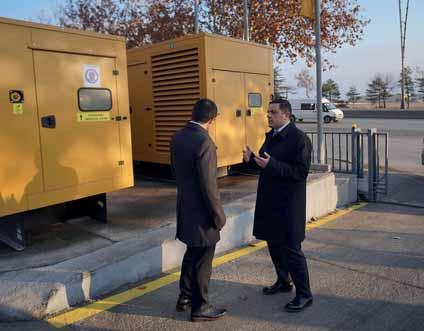
The agency notes that these are industrial generators with a total value of 1.5 million GEL, with the help of which hospitals, food facilities and other essential facilities will be able to work in an emergency mode.
Chargé d’Affaires of the Embassy of Ukraine Andriy Kasyanov personally thanked the Government of Georgia and the Prime Minister for the assistance provided.
“I am happy to note that the Govern-
ment of Georgia has purchased 25 highpower generators for Ukraine, which will be used for industrial purposes –clinics, hospitals, food facilities and other essential facilities of Ukraine. I would like to take this opportunity to express my personal gratitude for this decision of the Prime Minister of Georgia, Mr. Irakli Garibashvili. Also, I would like to thank all members of the Georgian Government for quickly implementing this decision, as all 25 generators will be sent to Ukraine today. I thank all Georgians for the very strong and essential support for my country and my people at this very critical time,” said Andriy Kasyanov. The Deputy Minister noted that the Government of Georgia and the Georgian people from the very first day of the beginning of hostilities in Ukraine have spared no effort to provide assistance to the Ukrainian people as much as possible.
GEORGIA TODAY DECEMBER 23 - 29, 2022 8 BUSINESS
SABUKO to Ensure Harmonized Human–Nature
Relationship on Kakheti Steppes: Balancing between a Living Landscape or a Future Desert

The Georgian steppe, spanning the area between the Iori and Alazani rivers, hosts a unique mixture of Palearctic, Indomalayan and Afrotropical fauna, including jackals, wolves and vultures. It was once home to the elusive Caucasian leopard. The steppe has been used for millennia as winter pastures by semi-nomadic pastoralists, with tens of thousands of sheep, but a combination of climate change and the increased number of grazing livestock is causing the degradation of this fragile habitat.
To improve the dire situation on the ground, the organization SABUKO (Society for Nature Conservation and Birdlife Partner in Georgia) has been implementing the landscape restoration project since January 1, 2019, with the support of the Cambridge Conservation Initiative. As part of the project, the organization developed a rotational grazing scheme, which noticeably improved the grass cover condition on the ground.
Following the successfully implemented first phase of the project ‘Restoring Gallery Forest and Grasslands in the Iori River Valley,’ now, SABUKO, along with its partners, is launching the second phase, which will build on the progress made by the completed ELP-funded Iori River Valley project, scaling up grassland restoration and continuing work with the pastoralist community to recover and to reconnect wildlife corridors from Kakheti to Vashlovani.
Livestock grazing determines the rise or demise of biodiversity in these steppe landscapes. Previously, ELP funded experimental rotational grazing in the Chachuna Reserve with promising results. Following that experience, together with its Georgian BirdLife Partner SABUKO, the Endangered Landscapes Program will scale up grassland restoration to 25,000 ha.
The goal of the project is to preserve the steppe and semi-arid landscapes between the Iori and Alazani rivers in southern Georgia, and restore wildlife, ecosystems and cultural values unique in Europe.
However, the implementation of these goals depend on several points, such as stopping the degradation of grasslands, connectivity of eco-corridors and reduced poaching and other pressures on wildlife.
Over five years (2023-2027), the project “The Kakheti Steppes: Balancing between a Living Landscape or a Future Desert” is expected to achieve three positive outcomes for the Iori Plateau – Vashlovani plateau:
• 500 km2 of steppes grazed sustainably by wildlife and livestock and managed for climate change adaptation;
• 1000 km2 of core areas and corridors of suitable habitat conserved across the landscape so that connectivity of wildlife populations is guaranteed;
• The future of ecologically sustainable rangeland management in Georgia is
secured through successful knowledge transfer, increased financial sustainability and raised awareness.
The first stage of the project covered the Chachuna Managed Reserve located in Georgia’s Dedoplistskaro municipality, which has faced a severe problem of degradation due to unregulated grazing, while the second phase covers Chachuna, Kotsakhura Range, Samukhi Valley and Vashlovani Protected Area, covering a territory of 25,000 ha in total.
To find out more about the second phase of the project implemented by SABUKO and its expected outcomes, GEORGIA TODAY spoke to several members of SABUKO.
Tinatin Arveladze, Policy Manager: “This is the second phase of the project.
During its first phase, we worked in the Chachuna Reserve, while the team responsible for policy was mainly focused on pastures. The problem was that both in the territory of Chachuna Reserve and its surrounding state-owned areas, sheep moved chaotically and there was no regulation at official level to monitor this issue. The legislation regarding pastures was very generalthere were no relevant normative acts.
The management of the Agency of Protected Areas tried to control the process, however, resources were not enough.
To solve this problem, the SABUKO team arranged a fence on the spot to prevent the chaotic sheep movement and grazing. The legislative change was adopted on 6 October 2021. SABUKO contributed to this process even prior to introduction of the legislative regulation, as it developed a rotational grazing scheme. Adopting the legislative act was a big goal for SABUKO. However, its implementation in practice also depends on the will, enthusiasm and work of locals and the Agency of Protected Areas. Protecting and restoring biodiversity is also a matter of each shepherds’ personal responsibility.
“Now, starting the new, second phase of the project, we can boldly say that we’ve already got a foundation for future activities and, based on the experience gained during the first phase, we know what needs to be changed and improved. Our main goal will be to show the local
shepherds the necessity for sustainable use of pastures. Moreover, we’ll do our best to ensure that their interests and needs are also protected.

“Sustainable use of water resources will be also an important part of our agenda. As such, we’ll work to ensure that Dali Reservoir and River Iori are not perceived as only a means of irrigation and more emphasis is made on their conservation.
“We’ll also pay attention to the status change of agricultural lands. There are often conflicts regarding the use of land resources and their sufficiency. As such, we’ll work to ensure that those lands identified as “important” in terms of biodiversity are not used improperly,” she noted.
Tinatin added that SABUKO will also focus on the Emerald Network Sites located in the project area and develop plans for their sustainable management, in addition to solving issues related to environment and sustainable use of natural resources on the spot.
German expert Marinus Gebhardt, a Natural Resources Manager, welcomed the fact that, as part of the new phase of the project, the SABUKO team will not only be able to continue work in Chachuna Reserve, but to expand the study area to Samukhi and Vashlovani, a big complex of winter pasture in Georgia.
“Winter pastures are the areas where degradation mostly takes place, so we’re really happy to be able to expand our studies and activities now to Chachuna, Samukhi and Vashlovani, thanks to Endangered Landscapes Programme,” Gebhardt says. “Now, we’re stepping in the second phase, which is an important opportunity. Our main focus is to care not only about the nature, but also about the people living in this nature. As such, this project is a chance to promote sustainable land use among the local shepherds and the population as a whole.
“Another thing we really facilitate is that the state cares more for that pasture. We plan to make a pasture degradation alert system integrated within a platform, so the state can see what is really going on on the pasture, which also contributes to better leasing contracts and so on. SABUKO really contributes to better
understanding of pastures. Forest is very inventoried in Georgia, but pastures not, so there’s a lack of knowledge about them. This project will contribute to expanding and improving this knowledge, too,” he said.
Giorgi Chikorashvili, local coordinator, notes that the second phase of the project SABUKO has started is important for both nature, environment and socioeconomic conditions in the region.
“In the first part of the project, SABUKO achieved tangible results by introducing rotational grazing, which was also well visible for the local population; they saw that the green grass cover around them was improved, which is very important work for them. Harmonized relationship between humans and nature is the main principle of this project, and we, the SABUKO team, are doing our best to implement it properly and bring even more benefits to the local environment and residents,” he pointed out.
Apart from being a local coordinator, Chikorashvili, along with his colleagues, is also involved in the parliamentary agrarian group, working on issues related to pastures, such as grazing methods, etc., to strengthen the pastures management legislation at the state level and raise awareness about the importance of their sustainable use among the population.
In the second phase of the project, the role of education has increased.
Gvantsa Bragvadze, Education Program Manager, notes that one of the most important innovations related to the project is the youth grant, the purpose of which is to provide practical knowledge and experience for young people interested in conservation. ELP will finance 3 to 5 projects annually until 2027.
“Local researchers and activists between the age of 18 and 25 will be able to participate in the grant competition, and will be mentored by SABUKO. The duration of each project will be from 3 to 6 months,” Bragvadze tells us. “We have several target groups. Planned activities include questionnaires to assess where we lack information and working and informational meetings with farmers, shepherds, representatives of the munic-
ipality, and employees of the administration of protected areas. For instance, one of the tasks of the project is to advocate for the process of harmonization of Georgian legislation with the EU Water Framework Directive, for which we will work together with SABUKO’s policy direction team in workshops with representatives of the municipality.
“In addition, together with the communication team, we are trying to ensure that many people have the right information about Chachuna and the project. We’re also preparing informational materials about Chachuna,, floodplain forest and its biodiversity - booklets, posters, materials for teachers and guides for different target groups. For example, in the first phase, a board game was created for students “Playing in Iori Floodplain", which is very informative and fun. Students not only get information about pastures, biodiversity, but also deal with the real problems farmers are facing.”
Londa Beria, Communications Manager, claims that in the new phase of the project, just like in the first, one of the main focuses will be put on the local people - farmers, shepherds, land owners, because the sustainable management practices of pastures and land resource use should be followed by as many of them as possible. Therefore, she says, the SABUKO team is going to spend a lot of energy on communicating with them and bringing them the benefits of the plan. Also, they intend to bring their opinions to the decision makers and ensure that this communication actually takes place.
“Chachuna Reserve and its biodiversity, its species, landscape and problems have come under the attention of many people over the years. People began to show their support by offering to help, participating in field trips, donating to purchase equipment for researching the species, buying tickets to a movie about Chachuna, and other forms of support.
In the new phase, we will try to create a similar emotional connection with people towards new areas, especially the areas of Kotsakhura and Samukhi, other species common here.
“In the new phase, we will try to make the project and its results visible at the international level, because the plan that was developed with us, if it works as successfully, can be used to manage and protect other protected areas. There is also a great interest in individual species, especially when it comes to vulnerable species, for example, the lynx, and we will try to raise attention of other important issues with these topics,” Londa told us.
Over the next five years, the SABUKO team, thanks to its donors and partners, will continue to spare no efforts to revitalize the ecosystem, ensure a harmonized relationship between humans and nature, and improve the socio-economic conditions of locals, this time on an even bigger operating area.
GEORGIA TODAY DECEMBER 23 - 29, 2022 9 SOCIETY
Ukrainian Children from Olympic School of War- Affected City of Mykolaiv Visit Tbilisi

The Ukrainian children from the Olympic School of the war-affected city of Mykolaiv visied Tbilisi in a trip organized by the Parliament of Georgia and Tbilisi City Hall.
The Vice-Speaker, the Head of the Georgia-Ukraine Friendship Group, Archil Talakvadze welcomed the Ukrainian MP, the Co-Chair of the UkraineGeorgia Friendship Group, Lyudmila Marchenko, and the Ukrainian children at Tbilisi Airport.
“It is yet another project and solidarity initiative to host war-affected Ukrainian children in Georgia. By this act, we would like to express the support of our country and our people and host them in Georgia to enjoy the Christmas and New Year eves together with our children.
After their city was bombarded, these children had to spend a long time in the shelter, while their parents defend their homeland in the war. It is particularly important for us to express our solidarity and make them feel at home, providing them with a safe, peaceful and posi-
tive two weeks in Georgia. I would like to thank Tbilisi City Hall and Tbilisi Mayor, Kakha Kaladze for financing the project, and thank the Foreign Ministry and the Georgian Embassy in Kyiv for organizing this project,” Talakvadze stated.
The Ukrainian children, accompanied by their coaches, will spend 10 days in Georgia and stay at the Football Academy “Dinamo” base. Within the culturalcognitive and rehabilitation program that is offered to them, these children will enjoy various activities, including meeting theTbilisi Mayor, avisit to the Parliament and a meeting with the Speaker.
As the Head of the Culture, Education, Sports and Youth Affairs Office of Tbilisi City Hall, Irakli Gvilava noted, “The program we offer is very interesting. We are aspired to facilitate their entertainment, leisure and sports activities. We have selected a sports school and school base for their accommodation and they are sure to spend an interesting and fullof-joy 10 days in Georgia.”
32 Students from 8 Georgian Universities Receive “Green Scholarships”
Thirty-two students from eight Georgian universities received “Green Scholarships” to continue their graduate studies in ecology, hydrology, geology, energy, mineral resources management, sustainable development and environmental policy.
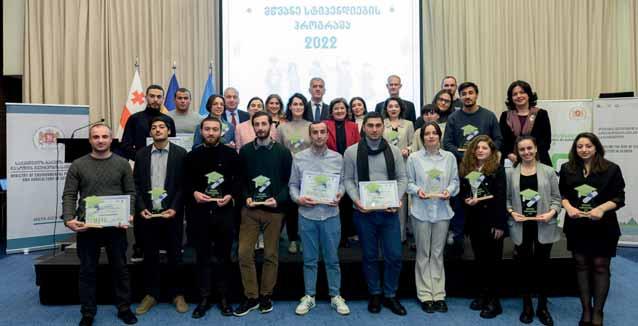
Representatives from UNDP, the Swedish Embassy, the Ministry of Environmental Protection and Agriculture and the Environmental Information and Education Center handed over the scholarship certificates on 20 December.
UNDP and the Government of Georgia, with funding from the Green Climate Fund (GCF), Swiss and Swedish governments are implementing a 7-year program dedicated to reducing the risk of climatedriven disasters in Georgia.
With an overall budget of $74 million, the initiative comprises three interrelated projects:
• Scaling-up Multi-Hazard Early Warning System and the Use of Climate Information in Georgia with USD 27 million funding from the Green Climate Fund (GCF);
• Strengthening the Climate Adaptation Capacities in Georgia with USD 5 million funding from the Swiss Agency for Development and Cooperation (SDC); and
• Improved Resilience of Communities to Climate Risks with USD 4 million funding from the Swedish International Development Cooperation Agency (SIDA).
The program is co-financed by the Government of Georgia with $38 million.
The initiative aims to reduce exposure of Georgia’s communities, livelihoods and infrastructure to climate-induced natural hazards through a well-functioning nationwide multi-hazard early warning system and risk-informed local action.
In close cooperation with the Ministry of Environment Protection and Agriculture of Georgia, National Environmental Agency, National Food Agency, Environmental Information and Education Centre, Emergency Management Service, the Ministry of Internal Affairs and the Ministry of Regional Development and Infrastructure, UNDP works to:
• Upgrade and expand the hydrometeorological and agrometeorological monitoring network, and support establishment of centralized multi-hazard risk information and knowledge system, consisting of national e-Library, databases, information systems and knowledge portal. Local-level detailed hazard mapping and risk and vulnerability assessment will be developed.
• Address gaps in national coordination and institutional setup for effective
early warning system (EWS) resulting in a functioning coordination mechanism and communication protocols for early warning. Capacities of decision-makers and national institutions involved in generating, processing, communicating, and using the warnings and other climate information will be enhanced. National and local integrated early warning sys-
tems by hazard and sectors will be developed and implemented.
• Secure delivery and use of the early warnings and climate advisories with end-users. Communities’ capacity to effectively utilize the EWS information and products and respond to climaterelated disasters through planning and implementing structural and non-struc-
Hang it All
space as carefully as I can. The next challenge has been to find a printer for some things I want to add to my considerable collection of pieces ready for framing or even hanging. I had been counting on the Kodak professional shop opposite the Philharmonia. But their big printer has been out of commission for some time now, and they’re not able to tell me when it might be back in action. Ordinary printers around the city can’t offer either the sizes (larger than A3) or the quality I need.
and glass, I’m readying more of my best photos from a huge set all on external hard drives. Some of these I’m carefully upsizing and working on, minimizing their grain while improving sharpness. My old camera equipment, some 35mm film (now scanned) and some digital from 12 to 24 mega-pixels needs all the help it can get, especially when I’m wanting to have just a FEW pieces at 1m wide or more…
tural resilience measures will be enhanced. In addition, the project will implement priority structural intervention measures in high-risk areas addressing the most vulnerable communities (based on sound cost-benefit analysis using the socio-economic risk model) to reduce the risks that the EWS will be designed to address.
BY TONY HANMER
She knew… my wife knew that if we got married, two things would be part of that. One, living in Svaneti. We’re just now taking our first full-winter break from there after 13 years. The other, living in my own gallery, practically a
lifelong dream. I printed a few pieces and hung them in the big Svaneti house, but (just as well) didn’t complete that task. And now here we are in our possible retirement flat in Tbilisi.
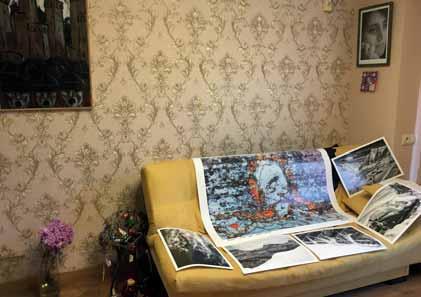
It’s much smaller: less than ¼ the size of the mountain house. But in both places, I had renovators put in gallery rails where the walls meet the ceilings. These allow you to hang anything using hooks and wire, and no nails. I’m going to fill this
Eventually a Fuji printer further along Melikishvili street turned up. After a few test pieces, I’m satisfied with their quality; they can do 1m wide by the length of the roll (many m), which is plenty, even for me!
A framer near that shop now has 12 or so pieces of my existing collection, an eclectic set of photos (mine and others’) and screen prints (mine) and more. While these are getting prepared over a week, all in actual wood frames with mattes
With only 4 rooms to fill, it’s going to be tight. There’s not enough space to devote a room to each location or theme: Georgia, Zimbabwe, Canada, the UK, Russia, miscellaneous. Walls might be the way I differentiate these subjects, with up to several rows together. The goal will be to fill the spaces without overdoing it, so it’s going to be tricky. I must say I’m enjoying the challenge, which has been decades coming while I have moved from place to place and even country to country. It has finally become time to
settle down, thus this big push. Pride of place goes, for now, to a large impressionistic painting by Budu Sirbiladze from 1962. It depicts the heads of 9 Svan men singing in front of 7 watchtowers, and I love it. What I choose to put on my walls will be pieces which I can look at over and over again and delight in; they’ll never get old. I also want to add a few more Georgian painters. Photos of family too, including a couple of my parents and my wife, mixed in among the landscapes and nature. Soon, Hanmer House and Gallery (Tbilisi) will be open for visitors.
Tony Hanmer has lived in Georgia since 1999, in Svaneti since 2007, and been a weekly writer and photographer for GT since early 2011. He runs the “Svaneti Renaissance” Facebook group, now with nearly 2000 members, at www.facebook.com/ groups/SvanetiRenaissance/ He and his wife also run their own guest house in Etseri: www.facebook.com/hanmer.house.svaneti
GEORGIA TODAY DECEMBER 23 - 29, 2022 10 SOCIETY
BLOG
Hoda Ceramics - Journey of an Architect Becoming a Ceramist


ceramics and has a studio workshop, Hoda, at 42 Vertskhli Street, Tbilisi, she still receives private orders for interior design. In her studio, she offers ceramic courses and workshops for anyone interested in learning the craft.

GEORGIA TODAY sat down with her to find out more.
“I became interested in ceramics about 8-10 years ago, looking at finished products online. I find it a very versatile and exciting profession that enables you to work in different directions. And most importantly, it’s a great way to implement an idea.
“I’m an interior designer by profession, and ceramics presented an opportunity for me to convey my designs or ideas in clay.
BY BAIA DZAGNIDZE
Kristine Dzagnidze is an interior designer-ceramist by profession. Although she initially studied architecture at Tbilisi Technical University, after two years, she decided to continue her studies as an Interior Designer at the Academy of Arts.
After graduation, she worked as an Interior Designer in different companies, from time to time also taking on the fun and challenges of different handicrafts, seeing her learning embroidery, sewing, goldsmithry, enameling, and cameo carving. Finally, she discovered ceramics was what she had always been looking for, and so, years later, she returned to the Academy of Arts to study ceramics professionally and get a Master's Degree. Although she now devotes her time to
“I started studying ceramics with ceramist Marika Izoria. I sat in her workshop for hours, where I had complete freedom to work on my ideas, and Marika taught me how to feel the material, create a shape, and process it with different techniques. Then I took courses at the Academy of Arts and decided to enroll in the Master's program.”
HOW WOULD YOU DESCRIBE YOUR STYLE, AND HOW DID YOU DEVELOP IT?
My products mainly have a decorative purpose because I’m working specifically on developing my studio workshop at this stage. Currently, my focus is on painting or sculpting figures. I’ve also developed my own processing technique for a particular collection, but at the moment, I can’t create such products because it requires quite a lot of time. I will definitely come back to it one day.
HOW LONG DOES IT TAKE TO CREATE ONE ITEM FROM START TO FINISH?
Depending on the item's simplicity or complexity, it takes about 10-14 days, sometimes more.
First, I sketch the item and think about how to start crafting a form based on that sketch; then in the working process, I gradually change methods or create a new form and follow the idea that comes in the moment. After sculpting, I leave the product to dry for five days, then, it is time to smooth and refine the surface, after which it's painted and finally finished with two firings.
WHAT IS THE MOST CHALLENGING PART OF WORKING IN CERAMICS?
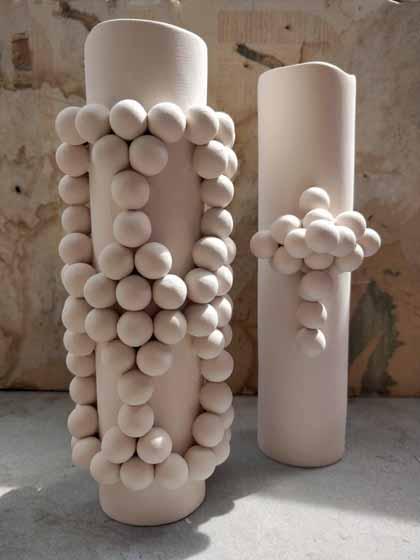
Transferring an idea from sketch into an actual product. There are many factors to consider, and often you may not be able to create precisely what you drew. After that, the most difficult thing is the correct application of color and glaze, and matching them with the form.
WHAT IS YOUR SOURCE OF INSPIRATION?
I’m usually inspired by the environment, nature, Tbilisi's architecture, and any emotion, form, texture, or pattern I might notice while walking through the capital.
HOW DO YOUR WORKS DIFFER FROM THOSE OF
OTHER WORKSHOPS?
It’s difficult for me to compare my work with others. In general, every workshop has its own signature. In my case, I am thrilled to see the smiling faces of customers admiring my very different items.
DO YOU ONLY CREATE INTERIOR DECORATIONS, OR DO YOU HAVE OTHER DIRECTIONS?
In addition to my workshop, I work in other directions with ceramist Salome Gavasheli. We create voluminous tiles and objects for the interior, where we
try to add a Georgian character by using our country’s architecture and nature as our inspiration.
& GM George
COMMERCIAL DEPARTMENT Commercial Director: Iva Merabishvili Marketing Manager: Natalia Chikvaidze
EDITORIAL DEPARTMENT: Editor-In-Chief: Katie Ruth Davies
Journalists: Ana Dumbadze, Vazha Tavberidze, Tony Hanmer, Emil Avdaliani, Nugzar B. Ruhadze, Michael Godwin, Ketevan Skhirtladze, Mariam Mtivlishvili, Erekle Poladishvili
Photographer: Aleksei Serov
Website Manager/Editor: Katie Ruth Davies Layout: Misha Mchedlishvili Webmaster: Sergey Gevenov Circulation Managers: David Kerdikashvili, David Djandjgava
ADDRESS
DO
YOU HAVE A DREAM PROJECT THAT YOU WANT TO IMPLEMENT?
Yes, I have several, and I hope to be able to implement them soon.
Hoda Ceramic links: Facebook: facebook.com/hodaceramics Instagram: instagram.com/hoda_ceramics
ADVERTISING & SUBSCRIPTION +995 555 00 14 46 E-mail: marketing@georgiatoday.ge
Reproducing material, photos and advertisements without prior editorial permission is strictly forbidden. The author is responsible for all material. Rights of authors are preserved. The newspaper is registered in Mtatsminda district court.
GEORGIA TODAY DECEMBER 23 - 29, 2022 11 CULTURE GEORGIA TODAY
PUBLISHER
Sharashidze
1 Melikishvili Str. Tbilisi, 0179, Georgia Tel.: +995 32 229 59 19 E: info@georgiatoday.ge F: GeorgiaToday
Reg. # 06/4-309
INTERVIEW




 BY ANA DUMBADZE
BY ANA DUMBADZE











 ANALYSIS BY EMIL AVDALIANI
ANALYSIS BY EMIL AVDALIANI



















